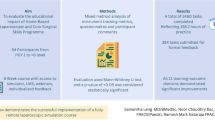Abstract
Objective
To compare the effectiveness of traditional and online teaching methods for educating anesthesiology residents in the principles and practice of difficult airway management.
Design
Prospective, randomized, controlled trial.
Setting
University hospital.
Participants
Two randomly selected groups, each containing 28 physicians enrolled from among residents in Anesthesiology and Intensive Care Medicine in Italy.
Interventions
Residents in Group 1 took a traditional 5-h course on the principles and practice of airway management, which included lectures, slide projection, and dummy demonstrations. The same material was presented to Group 2 in an exclusively online format, which could be individually accessed for a period of 36 h. In the online course, student-instructor interaction was provided through threaded discussion forums during three 30-min real-time question-and-answer sessions.
Measurements and results
Differences in baseline and post-course scores on written tests and practical skills tests were measured. Knowledge gains in Group 2 were slightly, but not significantly, greater compared with Group 1 both in written (P=0.228) and practical skills (P=0.376) tests. Semi-quantitative ratings of learner satisfaction were significantly higher in the online group (P=0.014). Almost all online students (93%) were logged in for at least 45 of the 90 min of real-time question-and-answer sessions. The four instructors spent an average of 144±10 min preparing answers and interacting with online students.
Conclusions
Online teaching formats may be a valid alternative for teaching residents the principles and practice of difficult airway management. Interaction with instructors seems to be an important element, but it may require substantial time commitments by instructors.


Similar content being viewed by others
References
Entwisle G, Entwisle DR (1963) The use of a digital computer as a teaching machine. J Med Educ 38:803–812
Piemme TE (1988) Computer-assisted learning and evaluation in medicine. JAMA 260:367–372
Tegtmeyer K, Ibsen L, Goldstein B (2000) Computer-assisted learning in critical care: from ENIAC to HAL. Crit Care Med 29:177–182
Computer communication for international collaboration in education in public health. The TEMPUS Consortium for a New Public Health in Hungary (1992) Ann NY Acad Sci 670:43–49
Sikorski R, Peters R (1998) Tools for change: CME on the Internet. JAMA 280:1013–1014
Chumley-Jones HS, Dobbie A, Alford CL (2002) Web-based learning: sound educational method or hype? A review of the evaluation literature. Acad Med 77:S86-S93
Bell DS, Fonarow GC, Hays RD, Mangione CM (2000) Self-study from Web-based and printed guideline materials. A randomized, controlled trial among resident physicians. Ann Intern Med 132:938–946
Lipman AJ, Sade RM, Glotzbach AL, Lancaster CJ, Marshall MF (2001) The incremental value of Internet-based instruction as an adjunct to classroom instruction: a prospective randomized study. Acad Med 76:1060–1064
Spickard A III, Alrajeh N, Cordray D, Gigante J (2002) Learning about screening using an online or live lecture. Does it matter? J Gen Intern Med 17:540–545
de Maio M, Ferreira MC (2001) Experience with the first Internet-based course at the Faculty of Medicine, University of Sao Paulo. Rev Hosp Clin Fac Med Sao Paulo 56:69–74
Rogers DA, Regehr G, Yeh KA, Howdieshell TR (1998) Computer-assisted learning versus a lecture and feedback seminar for teaching a basic surgical technical skill. Am J Surg 175:508–510
American Society of Anesthesiologists Task Force on Management of the Difficult Airway (2003) Practice guidelines for management of the difficult airway: an updated report by the American Society of Anesthesiologists Task Force on Management of the Difficult Airway. Anesthesiology 98:1269–1277
Berry AM, Brimacombe JR, Verghese C (1998) The laryngeal mask airway in emergency medicine, neonatal resuscitation, and intensive care medicine. Int Anesthesiol Clin 36:91–109
Ferson DZ, Rosenblatt WH, Johansen MJ, Osborn I, Ovassapian A (2001) Use of the intubating LMA-Fastrach in 254 patients with difficult-to-manage airways. Anesthesiology 95:1175–1181
Brain AI, Verghese C, Strube PJ (2000) The LMA ‘ProSeal’ - a laryngeal mask with an oesophageal vent. Br J Anaesth 84:650–654
Frass M, Rodler S, Frenzer R, Ilias W, Leithner C, Lackner F (1989) Esophageal tracheal combitube, endotracheal airway, and mask: comparison of ventilatory pressure curves. J Trauma 29:1476–1479
Hung OR, Pytka S, Morris I, Murphy M, Launcelott G, Stevens S, MacKay W, Stewart RD (1995) Clinical trial of a new lightwand device (Trachlight) to intubate the trachea. Anesthesiology 83:509–514
Stasiuk RBP (2001) Improving styletted oral tracheal intubation: rational use of the OTSU. Can J Anesth 48:911–918
Ovassapian A (1996) Fiberoptic tracheal intubation in adults. In: Ovassapian A (ed) Fiberoptic endoscopy and the difficult airway, 2nd edn. Lippincott-Raven, Philadelphia, pp 71–103
Corke C, Cranswick P (1988) A Seldinger technique for minitracheostomy insertion. Anaesth Intensive Care 16:206–207
Benumof JL, Scheller MS (1989) The importance of transtracheal jet ventilation in the management of the difficult airway. Anesthesiology 71:769–778
Colliver JA (2000) Effectiveness of problem-based learning curricula: research and theory. Acad Med 75:259–266
Cimino C, Reichel J, Serrano M (1995) Cost efficient management of educational material. Proc Annu Symp Computer Appl Med Care 493–497
Author information
Authors and Affiliations
Corresponding author
Electronic Supplementary Material
Rights and permissions
About this article
Cite this article
Bello, G., Pennisi, M.A., Maviglia, R. et al. Online vs live methods for teaching difficult airway management to anesthesiology residents. Intensive Care Med 31, 547–552 (2005). https://doi.org/10.1007/s00134-005-2561-0
Received:
Accepted:
Published:
Issue Date:
DOI: https://doi.org/10.1007/s00134-005-2561-0




